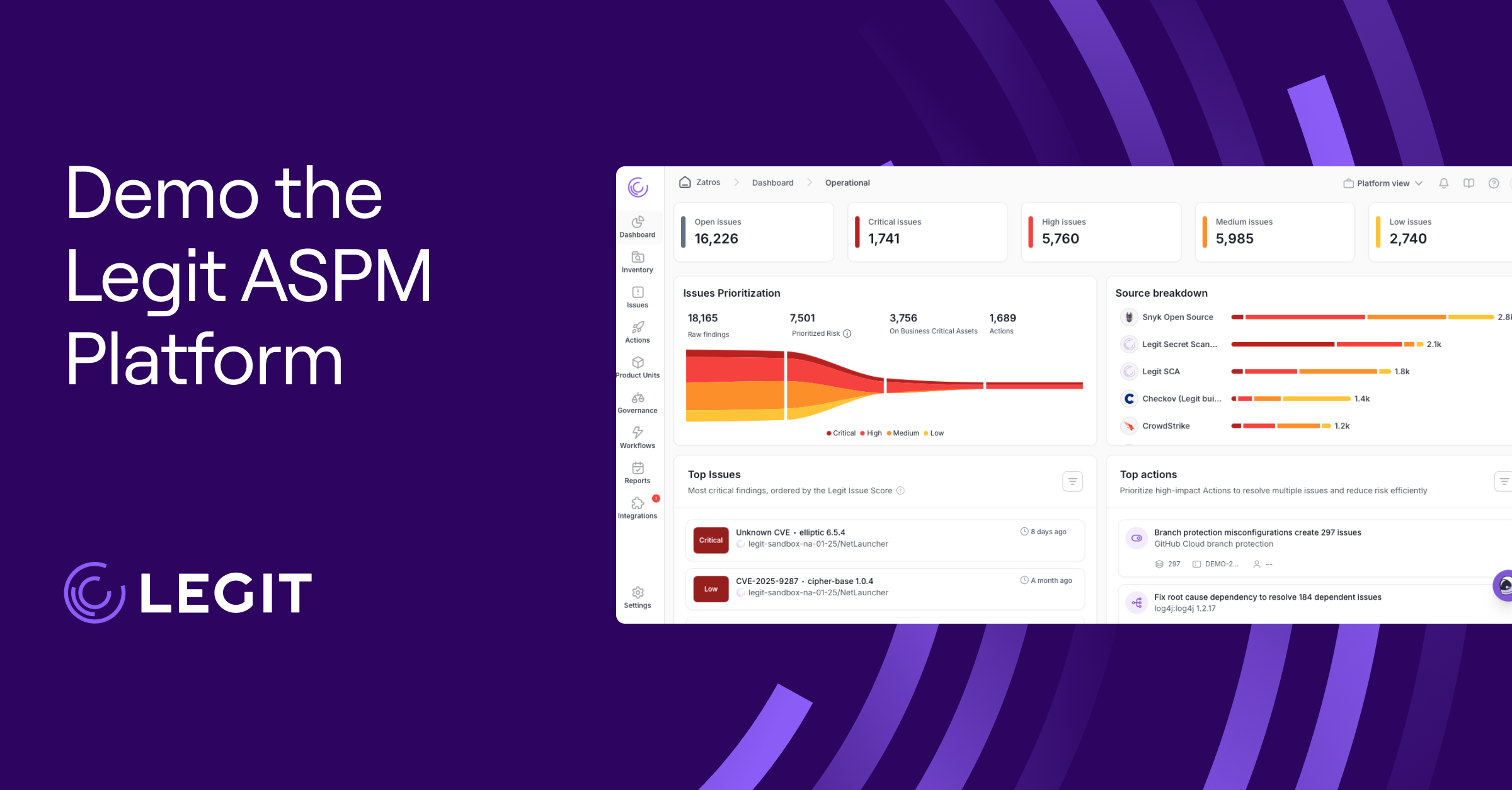With threat actors exploiting everything from compromised credentials to open-source packages, trusting by default creates too much risk. When traditional security models fail, Zero Trust steps in. Instead of assuming everything inside your perimeter is safe, Zero Trust treats every user, device, and system as untrusted until proven otherwise.
That shift in mindset is why Zero Trust solutions have become a growing priority for security and engineering teams. As organizations look for ways to reduce risk without slowing innovation, Zero Trust provides a framework that adapts to complex development environments and evolving threats.
Here’s how to implement Zero Trust, including the best solutions and tools.
What Is Zero Trust Security?
Zero Trust is a security framework that assumes a user or tool is a threat instead of trusting them immediately—no more implicit access. It operates on one simple principle: never trust, always verify. Zero Trust tools evaluate every access request in real time based on who’s asking, what they’re using, and what they’re trying to do.
Zero Trust applies whether the request comes from inside your network or halfway across the world. It’s also grounded in the principle of assumed breach, which is the idea that attackers may already be inside your environment. Every access request must be verified in real time.
Unlike legacy models that grant access once you log in, the Zero Trust model enforces continuous validation. It checks identity, device health, and behavior every time a user or system attempts a connection, with no exceptions. This approach limits the potential fallout of a breach since attackers can’t freely move laterally once inside. Constant verification closes blind spots, enforces least-privileged access, and detects risky behavior from a user or a system.
What Are Zero Trust Tools?
Zero Trust tools are the technologies that make the framework real. These solutions form the backbone of any Zero Trust security solution by applying continuous verification across users, devices, and systems.
These tools allow organizations to consistently enforce Zero Trust policies, even in highly distributed or hybrid environments. Most Zero Trust software includes identity and access management (IAM), multi-factor authentication, and Zero Trust Network Access (ZTNA). Microsegmentation and continuous monitoring further reduce risk by isolating assets and detecting threats early.
These tools also integrate into engineering workflows to support CI/CD security. They strengthen your overall security posture by ensuring only verified code, users, and processes move through development pipelines into production.
What Are the Benefits of Zero Trust?
Zero Trust is a practical way to build stronger defenses across your business. Here’s what you stand to gain:
- Reduces breach impact: By continuously verifying users and devices, Zero Trust contains threats before they can move laterally through the network, limiting damage if a compromise occurs.
- Supports hybrid work and cloud adoption: Whether your teams are remote, on-prem, or operating in a multi-cloud environment, Zero Trust provides consistent, secure access without relying on a fixed perimeter.
- Strengthens compliance: Built-in access controls and monitoring features align with regulations like NIST and FedRAMP, making it easier to demonstrate compliance across distributed environments.
- Minimizes operational complexity: A unified Zero Trust approach reduces the need for overlapping tools like VPNs and traditional firewalls, streamlining infrastructure and workflows.
- Improves threat detection: Continuous monitoring and contextual access decisions help surface abnormal activity faster, supporting a more proactive Zero Trust cybersecurity posture. These capabilities also complement top vulnerability management best practices.
- Enhances user experience: With direct-to-application access and fewer backhauls or bottlenecks, users get faster, more reliable connectivity—without the friction of legacy systems.
Important Zero Trust Technologies
Successful Zero Trust implementation requires adopting core solutions that work together to enforce its principles. These form the foundation for verifying identity, limiting access, monitoring activity, and containing threats across your environment.
- Identity and access management (IAM): IAM authenticates users, manages their permissions, and restricts access to only what they need and nothing more. IAM also supports a secure software development lifecycle (SDLC) by tightly controlling who can interact with sensitive systems and codebases.
- Multi-factor authentication (MFA): MFA adds an extra layer of protection and prevents account takeover, even if attackers obtain valid credentials.
- Endpoint verification: This process confirms that every device connecting to your environment is secure, compliant, and in the hands of a legitimate user.
- Zero Trust Network Access (ZTNA): ZTNA provides secure, app-specific access without exposing the network, making it a modern alternative to legacy VPNs.
- Microsegmentation: Isolate workloads, systems, and data with granular policies to block unauthorized movement across your environment.
- Continuous monitoring: Continuous monitoring tracks user behavior and system activity in real time, helping detect and respond to suspicious patterns early.
- Automated policy enforcement: Automation reduces your workload by applying consistent, context-aware access rules across users, assets, and environments.
- Threat detection and response: This helps security teams spot breaches faster and take action before the damage spreads—especially in areas like secrets management where leaked tokens and credentials often go unnoticed.
Top 10 Zero Trust Tools
Below are 10 of the best Zero Trust solutions out there, supporting key principles like continuous verification, least-privilege access, and microsegmentation.
1. StrongDM
StrongDM delivers dynamic access controls through continuous Zero Trust authorization. It evaluates context signals like user behavior, location, and device health in real time and adapts access permissions accordingly. With an advanced policy engine and unified policy management, it brings visibility and fine-tuned control to cloud, on-prem, and hybrid environments.
2. Twingate
Twingate’s Zero Trust network access platform replaces VPNs with faster, more secure connections. It offers application-level access filtering, seamless single sign-on (SSO) integration, and traffic encryption with split tunneling—without exposing resources to the public Internet. Users often praise the platform for its fast setup and minimal disruption to existing infrastructure.
3. JumpCloud
JumpCloud is a central hub for identity, access, and device management. Its Open Directory Platform supports conditional access and safe passwordless login across multiple platforms. Admins can enforce consistent policies across cloud and on-prem systems while integrating with common identity providers and productivity tools.
4. Okta
Okta’s Identity Cloud delivers flexible IAM with extensive integrations and adaptive multi-factor authentication. It supports granular access policies based on risk factors like device posture and geolocation, helping security teams enforce least-privilege access across distributed environments.
5. Zscaler
Zscaler’s Zero Trust Exchange (ZTE) inspects traffic—encrypted or not—and enforces least-privilege access with advanced security features like sandboxing, data loss prevention (DLP), and a cloud firewall. Its private access service (ZPA) connects users directly to internal apps without placing them on the network, significantly reducing the attack surface.
6. Google BeyondCorp
Based on Google’s internal architecture, BeyondCorp eliminates the VPN and shifts access control to user identity and device context. It supports hybrid work environments with browser-based endpoint verification and integrates threat protection and policy enforcement—all without agent installation.
7. Microsoft Entra
Previously known as Azure Active Directory, Microsoft Entra ID and Entra Private Access deliver scalable identity verification and secure app access. Features like conditional access policies, SSO, and biometric support replace legacy perimeter-based security with identity-first protection.
8. Cisco Duo
Cisco Duo combines strong user authentication with endpoint health checks. With MFA, passwordless login, and device visibility, you can block access from untrusted devices or risky behaviors while maintaining a smooth user experience. Its Duo Network Gateway also adds agentless access to internal apps from any device.
9. BeyondTrust
BeyondTrust’s suite of tools focuses on securing privileged accounts and enforcing least-privilege principles. Products like Password Safe and Endpoint Privilege Management give you detailed control over user permissions, enforce strong credential practices, and add auditing to sensitive systems.
10. ThreatLocker
ThreatLocker brings Zero Trust to the endpoint level. It uses deny-by-default policies, application allow listing, and device control to shut down unauthorized activity. With features like Ringfencing and Storage Control, it minimizes exposure to ransomware and insider threats even on remote or unmanaged devices.
Effectively Implement Zero Trust with Legit Security
Zero Trust is a strategic shift in how organizations think about access, verification, and security enforcement—from identity controls and microsegmentation to continuous monitoring and endpoint verification. But adopting these principles across fast-moving development pipelines isn’t always straightforward.
That’s where Legit Security comes in. Legit helps you integrate security into DevOps by embedding Zero Trust principles directly into the development workflow. It provides CI/CD visibility, policy enforcement, and automated controls that reduce friction between engineering and security teams.
Whether you're working to secure your software supply chain or improve visibility across development stages, Legit gives you the context and coverage needed to put Zero Trust into practice, without slowing your release cycles. Request a demo today.
Download our new whitepaper.


